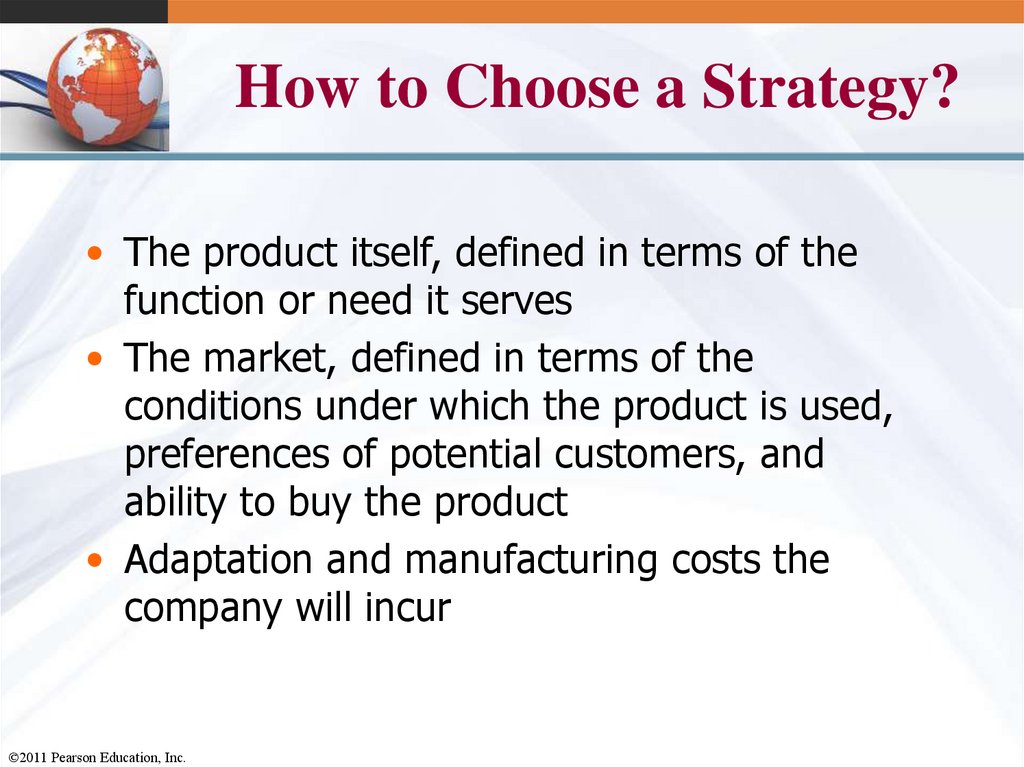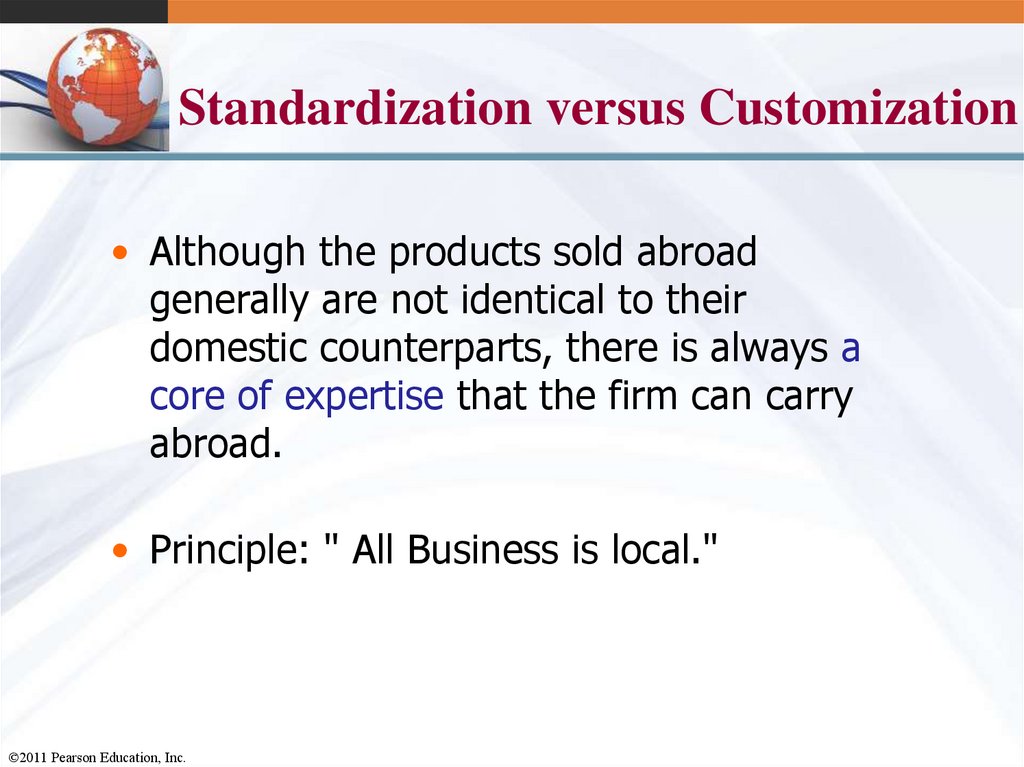Similar presentations:
Brand and product decisions in global marketing
1.
Branding andProduct
Decisions in
Global
Marketing
2.
Introduction to Brandsand Products
110v or 220v ?
©2011 Pearson Education, Inc.
Brand and product
concepts
Local, international,
and global brands
Product design issues
Attitudes towards
foreign products
Strategic alternatives
New product issues
3.
Basic Product Concepts• A product is a good,
service, or idea
– Tangible Attributes
– Intangible Attributes
• Product classification
– Consumer goods
– Industrial goods
©2011 Pearson Education, Inc.
PVC pipe is an example
of an industrial product.
4.
Buyer Orientation• Buyer orientation
– Amount of effort
expended
– Level of risk
– Buyer involvement
• Buyer orientation
framework
©2011 Pearson Education, Inc.
–
–
–
–
Convenience
Preference
Shopping
Specialty
5.
Brands• Bundle of images and experiences in the
customer’s mind
• A promise made by a particular company
about a particular product
• A quality certification
• Differentiation between competing products
• The sum of impressions about a brand is the
Brand Image
©2011 Pearson Education, Inc.
6.
Brands©2011 Pearson Education, Inc.
7.
Brand Equity• The added value that accrues to a
product as a result of investments in
the marketing of the brand
• An asset that represents the value
created by the relationship between the
brand and customer over time
©2011 Pearson Education, Inc.
8.
Brand Equity BenefitsGreater loyalty
Less vulnerability to marketing actions
Less vulnerability to marketing crises
Larger margins
More inelastic consumer response to price
increases
• More elastic consumer response to price
decreases
• Increased marketing communication
effectiveness
©2011 Pearson Education, Inc.
9.
Local Products and Brands• Brands that have achieved success in a
single national market
– Sometimes a global company may create
local products & brands (e.g.Coca-Cola in Japan)
• Represent the lifeblood of domestic
companies
• Entrenched local products/brands can be
a significant competitive hurdle to global
companies
©2011 Pearson Education, Inc.
10.
International Productsand Brands
• Offered in several
markets in a
particular region
– ‘Euro-brands’
– Honda 5-door
hatchback auto is
known as Fit in
Japan and Jazz in
Europe
©2011 Pearson Education, Inc.
The Smart car was developed by
DaimlerChrysler for the European
market and is now sold in the U.S.
11.
Global Products and Brands• Global products meet the wants and
needs of a global market and are
offered in all world regions
• Global brands have the same name and
similar image and positioning
throughout the world
Harley Davidson has
dealers in over 60
countries.
©2011 Pearson Education, Inc.
12.
Global Products and Brands“A multinational has operations in different
countries. A global company views the world as
a single country. We know Argentina and
France are different, but we treat them the
same. We sell them the same products, we use
the same production methods, we have the
same corporate policies. We even use the same
advertising—in a different language, of course.”
- Alfred Zeien Former Gillette CEO
©2011 Pearson Education, Inc.
13.
Global Brand Characteristics• Quality signal—allows a company to charge
premium price in a highly competitive market
• Global myth—marketers can use global
consumer culture positioning to link the brand
identity to any part of the world
• Social responsibility—shows how a company
addresses social problems
©2011 Pearson Education, Inc.
14.
Global Products and Brands• Global brands are
not the same as
global products
– mp3 player=
product
– iPod = brand
©2011 Pearson Education, Inc.
15.
Branding Strategies• Combination or tiered branding allows
marketers to leverage a company’s reputation
while developing a distinctive identity for a
line of products
– Sony Walkman
• Co-branding features two or more company
or product brands
– NutraSweet and Coca-Cola
– Intel Inside
©2011 Pearson Education, Inc.
16.
Brand Extension• Brand acts as an umbrella for new products
– Example: The Virgin Group
• Virgin Entertainment: Virgin Mega-stores and MGM
Cinemas
• Virgin Trading: Virgin Cola and Virgin Vodka
• Virgin Radio
• Virgin Rail (UK only)
• Virgin Media Group: Virgin Publishing, Virgin
Television, Virgin Net (UK only)
• Virgin Hotels
• Virgin Travel Group: Virgin America Airways, Virgin
Holidays, Virgin Galactic
©2011 Pearson Education, Inc.
17.
World’s Most Valuable Brands,2010 (Interbrand)
1.
2.
3.
4.
5.
6.
7.
8.
9.
10.
Coca-Cola
IBM
Microsoft
GE
McDonald’s
Intel
Nokia
Disney
HP
©2011 Pearson Education, Inc.
11. Toyota
12. Mercedes-Benz
13. Gilette
14. Cisco
15. BMW
16. Louis Vuitton
17. Apple
18. Marlboro
19. Samsung
20. Honda
21.
22.
23.
24.
25.
H&M
Oracle
Pepsi
American Express
Nike
18.
Private Label Branding• Large retailers are moving increasingly
into their own brand
• They try to obtain greater control and
higher margins.
• Private branding can be an effective way
to break into foreign markets.
©2011 Pearson Education, Inc.
19.
Global Brand Development• Questions to ask when management seeks to
build a global brand:
– Does this move fit the company and/or its
markets?
– Will anticipated scale economies materialize?
– How difficult will it be to develop a global brand
team?
– Can a single brand be imposed on all markets
successfully?
©2011 Pearson Education, Inc.
20.
Global Brand DevelopmentSuggestions to establish global brand leadership:
• Create a compelling value proposition
• Think about all elements of brand identity and
select names, marks, and symbols that have the
potential for globalization
• Research the alternatives of extending a national
brand versus adopting a new brand identity
globally
• Develop a company-wide communication system
©2011 Pearson Education, Inc.
21.
Global Brand Development• Develop a consistent planning process
• Assign specific responsibility for
managing branding issues
• Execute brand-building strategies
• Harmonize, unravel confusion, and
eliminate complexity
©2011 Pearson Education, Inc.
22.
Local versus Global Products andBrands: A Needs-Based Approach
Maslow’s Hierarchy of Needs
©2011 Pearson Education, Inc.
23.
Asian Hierarchy of Needs10-24
©2011 Pearson Education, Inc.
24.
Country of Origin asBrand Element
• Perceptions about and attitudes toward
particular countries often extend to
products and brands known to originate
in those countries
French perfume
– Japan
– Germany
– France
– Italy
©2011 Pearson Education, Inc.
25.
Country of Origin asBrand Element
• For many products, the “made in” label
matters a great deal to consumers.
• Key research findings of
COO effects:
• COO effects are not stable
• Both the country of design and
the country of manufacturing /
assembly play a role in consumer
attraction
©2011 Pearson Education, Inc.
26.
Packaging• Consumer Packaged Goods refers to products
whose packaging is designed to protect or
contain the product during shipping, at retail,
or point of use
• Eco-Packaging is key because package
designers must address environmental issues
• Offers communication cues that provide
consumers with a basis for making a
purchase decision
©2011 Pearson Education, Inc.
27.
Labeling• Provides consumers with
various types of information
• Regulations differ by country
regarding various products
– Health warnings on tobacco
products
– American Automobile Labeling
Act clarifies the country of
origin, and final assembly point
– European Union requires labels
on all food products that include
ingredients from genetically
modified crops
©2011 Pearson Education, Inc.
10-28
28.
Aesthetics• Global marketers must
understand the
importance of visual
aesthetics
• Aesthetic styles (degree of
complexity found on a label)
differ around the world
©2011 Pearson Education, Inc.
29.
Product Warranties• Express Warranty is a written guarantee
that assures the buyer is getting what
they paid for or provides a remedy in
case of a product failure
• Warranties can be used as a
competitive tool
©2011 Pearson Education, Inc.
30.
Global Product Strategies-- 3 Basic Strategies
Straight
Extension
The firm adopts the
same policy used in
its home market.
©2011 Pearson Education, Inc.
Product
Adaptation
The company caters
to the needs and wants
of its foreign
customers.
Product
Innovation
The firm designs a
product from scratch
for foreign customers.
31.
Extend, Adapt, Create: StrategicAlternatives in Global Marketing
• Extension – offering product virtually
unchanged in markets outside of home
country
• Adaptation – changing elements of design,
function, and packaging according to needs
of different country markets
• Creation – developing new products for the
world market
©2011 Pearson Education, Inc.
32.
3 Basic Strategies Can Be FurtherBroken Down Into 5 Options
International
Product Strategy
Strategy 1
Product and
Communication
Extension
Strategy 2
Product Extension
Communication
Adaptation
Strategy 3
Product
Adaptation
Communication
Extension
Strategy 4
Product and
Communication
Adaptation
Strategy 5
Product Invention
©2011 Pearson Education, Inc.
Product
Example
Consumer Need
Satisfied
Product
Strategy
Communication
Strategy
Gillette
Razor
Disposable, easy
to use product
Extension
Extension
Wrigley
Chewing Gum
USA: Substitute
for Smoking
Europe: Dental
benefits
Extension
Adaptation
McDonalds
Fast-Food
Extension:
Using global
campaign
Slim Fast
Identical:
Lose Weight
Adaptation:
Adding local
products to
range
Adaptation:
Consumer
preferences
for different
flavors
Buckler Beer
Non-alcoholic
beer
Invention
Adaptation:
Celebrity in Germany,
Teacher in UK
Develop new
communication
33.
Global Product Planning:Strategic Alternatives
Product
Same
Communication
Different
Same
©2011 Pearson Education, Inc.
Strategy 2:
Product Extension
Communication
Adaptation
Strategy 1:
Dual Extension
Different
Strategy 4:
Dual Adaptation
Strategy 3:
Product Adaptation
Communication
Extension
34.
Product Invention• Strategy 5:
– Important for reaching mass markets in
less industrialized nations and certain
segments in industrialized countries
• Hand-cranked radios for areas with no
electricity
• Total toothpaste by Colgate uses global benefit
segmentation
©2011 Pearson Education, Inc.
35.
How to Choose a Strategy?• Two errors that management makes in
choosing a strategy
– NIH (Not invented here) syndrome means
managers ignore the advancements of
subsidiaries overseas
– Managers impose policies upon subsidiaries
because they assume what is right for
customers in one market is right in every
market
©2011 Pearson Education, Inc.
36.
How to Choose a Strategy?• The product itself, defined in terms of the
function or need it serves
• The market, defined in terms of the
conditions under which the product is used,
preferences of potential customers, and
ability to buy the product
• Adaptation and manufacturing costs the
company will incur
©2011 Pearson Education, Inc.
37.
Standardization versus Customization• Although the products sold abroad
generally are not identical to their
domestic counterparts, there is always a
core of expertise that the firm can carry
abroad.
• Principle: " All Business is local."
©2011 Pearson Education, Inc.
38.
New Products in GlobalMarketing
• Pursue opportunities in competitive arenas of
global marketplace
• Focus on one or only a few businesses
• Active involvement from senior management
• Ability to recruit and retain best employees
• Understand the importance of speed in
bringing product to market
©2011 Pearson Education, Inc.
39.
Identifying New Product Ideas• What is a new product?
– New to those who use it or buy it
– New to the organization
– New to a market
©2011 Pearson Education, Inc.
40.
The InternationalNew Product Department
• How big is the market for this product at
various prices?
• What are the likely competitive moves in
response to our activity?
• Can we market the product through existing
structure?
• Can we source the product at a cost that will
yield an adequate profit?
• Does product fit our strategic development
plan?
©2011 Pearson Education, Inc.
41.
Testing New Products• When do you test a new product?
– Whenever a product interacts with human,
mechanical, or chemical elements because
there is the potential for a surprising and
unexpected incompatibility
• Test could simply be observing the
product being used within the market
©2011 Pearson Education, Inc.









































 marketing
marketing








